It is a positive commandment of the that whoever wishes to eat meat must first slaughter the animal, as it is written, “Thou shalt slaughter of thy herd and of thy flock, which the Lord hath given thee, as I have commanded thee, and thou shalt eat within thy gates, after all the desire of thy soul” (Deuteronomy 12:21). (Note: Administering electric shock to an animal prior to shehitah [ slaughtering] is prohibited, because it incapacitates the animal and renders it a trefah [animal unfit to eat]. It is forbidden to eat the meat of such an animal. The prohibition extends, as well, to administering an anesthetic, in the form of a drug and the like, since it may endanger the health and life of the animal and render it trefah prior to shehitah.)
This commandment applies equally to cattle, to animals, and to fowl. A limb torn or cut from a living animal is forbidden. An animal that is not slaughtered, but dies of itself, is prohibited. The laws regarding the precise method of slaughter are not stated in the Bible, but were given orally to Moses on Mount Sinai, as indicated in the verse by the statement, “as I have commanded thee,” that is, as I have already instructed you. [The function of this previous sentence is to make a link between rabbinically developed laws regarding implementation of these laws and what is traditionally understood as the revelation—of both oral and written Torah (which can be translated as both “teaching” and “law”)—at Sinai.]
2. Only one who is knowledgeable in the laws of slaughtering (shehitah) and proficient in its practice, and who is a believing, pious Jew, may act as a slaughterer (shohet) in performance of the commandment. It is the prevalent custom that the shohet must receive written authorization from a recognized rabbinical authority attesting to the aforesaid qualifications.
3. Shehitah must be done by means of a swift, smooth cut of a sharp knife whose blade is free of any dent or imperfection.

Help us keep Jewish knowledge accessible to millions of people around the world.
Your donation to My Jewish Learning fuels endless journeys of Jewish discovery. With your help, My Jewish Learning can continue to provide nonstop opportunities for learning, connection and growth.
4. Shehitah entails severing the trachea and the esophagus in accordance with the oral tradition, which requires that five improper procedures be avoided, lest they invalidate the shehitah and render the animal unfit to be eaten. They are (a) hesitation or delay while drawing the knife, (b) excessive pressure or chopping, (c) burrowing the knife between the trachea and the esophagus or under the skin, (d) making the incision outside the specified area, and (e) laceration or tearing of the trachea or esophagus, which would result from an imperfect blade. An animal or fowl that is improperly slaughtered (or, as already noted, that is not slaughtered, but dies of itself) is considered carrion (nevelah) and unfit for food.
5. It is forbidden to slaughter the parent with its young on the same day (Leviticus 22:28).
Defective Animals and Fowl
1. The Bible states, “Ye shall not eat any flesh that is torn of beasts in the field” (Exodus 22:30). This prohibition is taken to include other diseases or disorders that afflict the animal and cause it to die. Jewish tradition holds that eight kinds of trefah, that is, fatal organic defects that may afflict the animal and thereby render it unfit to be eaten, were imparted to Moses on Mount Sinai. They are (a) defects resulting from attack by a predatory beast or a bird of prey, (b) perforation or piercing of vital organs, (c) certain organs missing from birth, (d) non-congenital defects involving missing organs, (e) laceration or tearing of certain organs, (f) defects resulting from a fall, (g) severance of certain organs, and (h) fractures.
2. Since most animals are free of the above diseases or disorders, no special examination is required unless some defect is detected. However, the lungs of the animal must be carefully examined, since this is the area where defects are most likely to be found. Inspection must be done by one who is reliable and qualified, as it requires extensive knowledge of the laws and considerable skill and experience. (Note: Although m and Sephardim follow different procedures in their examination of the lungs in accord with the differing views of the Bet Yosef [Yosef Karo, author of the Shulhan Arukh) and the Rama [Rabbi Isserles, Ashkenazi author of the classic Mapat Ha-shulhan commentary printed as part of the Shulhan Arukh], nonetheless an Ashkenazic Jew may eat meat in the home of a Sephardic Jew, because we do not presume that any problem developed that would have rendered the meat forbidden. However, if a specific problem arises, one is obliged to inform the other so that he may refrain from eating, in accordance with his own tradition.)
Removal of Forbidden Fat, Veins and Sinews
1. The Bible considers certain fats in oxen, sheep, and goats to be forbidden (Leviticus 7:23-25). All forbidden fat (helev), such as fat covering the kidney, the spleen, and certain inward parts of the animal, must be removed before the meat is soaked and salted.
2. The “sinew of the thigh-vein that is upon the hollow of the thigh” is likewise biblically prohibited in animals (Genesis 32:33). Both the inner sinew and the outer sinew, and their branches, must be excised. (Note: Most of the forbidden fat and the sinew of the thigh vein are found in the hindquarters of the animal. Since their removal is difficult and must be done by one who is highly qualified, the hindquarters are not used for kosher meat in most Jewish communities, except where meat is not readily obtainable, as in Israel and some European communities.)
3. Veins and blood vessels are prohibited because of the blood that they contain that cannot be extracted by salting. Hence these forbidden veins, such as those in the forelegs, shoulder, lower jaws, tongue, neck, heart, and in the fat of the entrails, and other blood vessels and tissues must be removed before the meat is made kosher and cooked. In fowl, the blood vessels in the throat should be removed or cut through together with the neck. It is also customary to cut between the knee joints in order to reach the blood vessels that are there.
Reprinted, with permission from KtavPublishing, from The Concise Code of Jewish Law, Volume 1.



